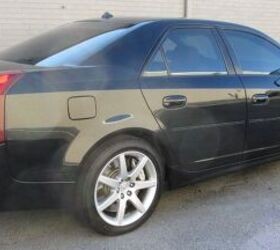The early 2000s were a transformative period for Cadillac. For decades, the brand had been synonymous with luxury barges, appealing primarily to an older demographic. But a shift was brewing in Detroit, and the 2004 Cadillac CTS-V was at the forefront of this change, signaling Cadillac’s serious entry into the performance sedan arena. This wasn’t your grandfather’s Cadillac; this was a machine engineered to thrill, borrowing its heart from the legendary Corvette Z06.
Why the CTS-V Became an Instant Classic
The allure of the 2004 CTS-V was immediately apparent to anyone with a pulse for performance. While the exterior styling might have initially been perceived as conservative by some, underneath the sharply creased sheet metal lay the soul of a true sports car. The key ingredient was the engine: the potent LS6 V8, directly lifted from the C5 Corvette Z06. This wasn’t a detuned or modified version; it was the genuine article, delivering a staggering 400 horsepower and 395 lb-ft of torque to the rear wheels.
Coupled with a robust Tremec T56 six-speed manual transmission, the CTS-V offered a driving experience that was raw, engaging, and unlike anything Cadillac had produced before. This powertrain combination wasn’t just about straight-line speed; it was about injecting adrenaline into the Cadillac brand and challenging the established European performance sedans. For enthusiasts craving American muscle with a touch of luxury, the 2004 CTS-V was an irresistible proposition.
On the Road: Performance and Handling
The driving experience of the first-generation CTS-V was a blend of exhilarating performance and raw, unfiltered feedback. Unlike later CTS-V models equipped with MagneRide suspension, the 2004 version featured a more traditional sport-tuned suspension setup. While some might debate the nuances of magnetic ride control, the conventional system in the 2004 CTS-V delivered impressive handling prowess. Many reviewers at the time, and even owners today, attest to its surprisingly capable handling, often drawing comparisons to European sports sedans known for their dynamic abilities.
However, this focus on handling came at a cost to ride comfort. The suspension, while adept at cornering, could be quite firm, translating road imperfections directly into the cabin. While this might be acceptable, even desirable, for performance purists, it was a departure from the plush ride typically associated with Cadillac. The 0-60 mph sprint was officially quoted at 4.6 seconds, and the quarter-mile in 13.1 seconds – figures that were genuinely impressive for the era and still hold up respectably today.
Despite the impressive performance figures, early models of the 2004 CTS-V were known to have a weak point: the differential. Aggressive launches or spirited driving could sometimes lead to differential failure, a problem that became a point of contention for some owners. Another area of criticism was the shifter feel of the Tremec T56. While the transmission itself was robust, the factory shifter was often described as having long throws and a somewhat vague feel, detracting slightly from the overall driving engagement. Many owners opted for aftermarket short-throw shifters to improve the precision and responsiveness of gear changes.
Design and Interior: A Nod to Performance
The exterior design of the 2004 CTS-V was characterized by sharp lines and angular styling, a departure from the curves and rounded edges prevalent in many cars of the time. The V-Series package added subtle yet effective enhancements, including unique front and rear fascias, mesh grille inserts, and more aggressive rocker panels. The 18-inch wheels, while contributing to the firm ride, also filled the wheel wells nicely and added to the car’s sporty stance.
Inside, the CTS-V offered comfortable and supportive seats, a thick-rimmed steering wheel, and generally good ergonomics. However, in typical early 2000s GM fashion, some of the interior materials, particularly on the center stack, were criticized for their less-than-premium feel. Despite this, the cabin was functional and spacious, offering ample room for passengers and a generously sized trunk. One peculiar design choice was the foot-operated parking brake, which added a fourth pedal to the footwell, potentially causing momentary confusion for drivers unfamiliar with the layout.
Verdict: A Landmark Performance Cadillac
The 2004 Cadillac CTS-V was more than just a performance sedan; it was a statement of intent from Cadillac. It demonstrated that the brand was serious about competing in the performance market and capable of producing a car that could genuinely challenge its European rivals. While not without its flaws – the firm ride, potential differential issues, and some interior material shortcomings – the 2004 CTS-V delivered a potent combination of Corvette-derived power, engaging handling, and distinctive styling.
For enthusiasts today, the 2004 CTS-V remains a significant and desirable car. It represents the dawn of Cadillac’s V-Series performance lineage and offers a raw, analog driving experience that is increasingly rare in modern performance vehicles. Its blend of American muscle and Cadillac refinement makes it a unique and compelling choice for those seeking a performance sedan with character and heritage. The 2004 CTS-V is not just a used car; it’s a piece of Cadillac’s performance history, and a testament to the brand’s resurgence in the 21st century.
